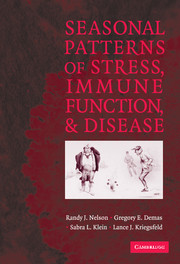Book contents
- Frontmatter
- Contents
- Acknowledgments
- Foreword
- Preface
- 1 Seasonality
- 2 Immune Function
- 3 Seasonal Fluctuations in Disease Prevalence
- 4 Seasonal Changes in Immune Function
- 5 Photoperiod, Melatonin, and Immunity
- 6 Energetics and Immune Function
- 7 Hormonal Influence on Immune Function
- 8 Clinical Significance of Seasonal Patterns of Immune Function and Disease
- References
- Index
4 - Seasonal Changes in Immune Function
Published online by Cambridge University Press: 11 November 2009
- Frontmatter
- Contents
- Acknowledgments
- Foreword
- Preface
- 1 Seasonality
- 2 Immune Function
- 3 Seasonal Fluctuations in Disease Prevalence
- 4 Seasonal Changes in Immune Function
- 5 Photoperiod, Melatonin, and Immunity
- 6 Energetics and Immune Function
- 7 Hormonal Influence on Immune Function
- 8 Clinical Significance of Seasonal Patterns of Immune Function and Disease
- References
- Index
Summary
Another year! – another deadly blow!
Wordsworth, November, 1806Introduction
In contrast to other physiological processes, immune function has been assumed to remain relatively constant across the seasons (see Sheldon & Verhulst 1996). Thus, seasonal fluctuations in death and disease were, historically, attributed to seasonal cycles in pathogen virulence and not to changes in host immunity (see Chapter 3 for details). Recent evidence, however, suggests that immune function varies substantially on a seasonal basis (Lochmiller et al. 1994; Nelson & Demas 1996). Maintaining maximal immune function is energetically expensive; the cascades of dividing immune cells, the onset and maintenance of inflammation and fever, and the production of humoral immune factors all require significant energy (Chapter 6; Maier et al. 1994; Demas et al. 1997). Energy utilization involves elevation of basal metabolic rate, blood glucose, and free fatty acid levels. Therefore, mounting an energetically costly immune response has the potential to compromise the ability to preserve protein stores in muscle (Beutler & Cerami 1988). Additionally, mounting an immune response requires resources that could otherwise be allocated to other biological functions (Sheldon & Verhulst 1996). Thus, it is reasonable to consider immune function in terms of energetic trade-offs. Individuals may partition resources among the immune system and other biological processes, such as reproduction, growth, or thermogenesis. Consequently, animals may maintain the highest level of immune function that is energetically possible, given the constraints of processes essential for survival, growth, reproduction, thermogenesis, foraging, and other activities (Festa-Bianchet 1989; Richner et al. 1995; Deerenberg et al. 1997).
- Type
- Chapter
- Information
- Seasonal Patterns of Stress, Immune Function, and Disease , pp. 89 - 114Publisher: Cambridge University PressPrint publication year: 2002
- 1
- Cited by



